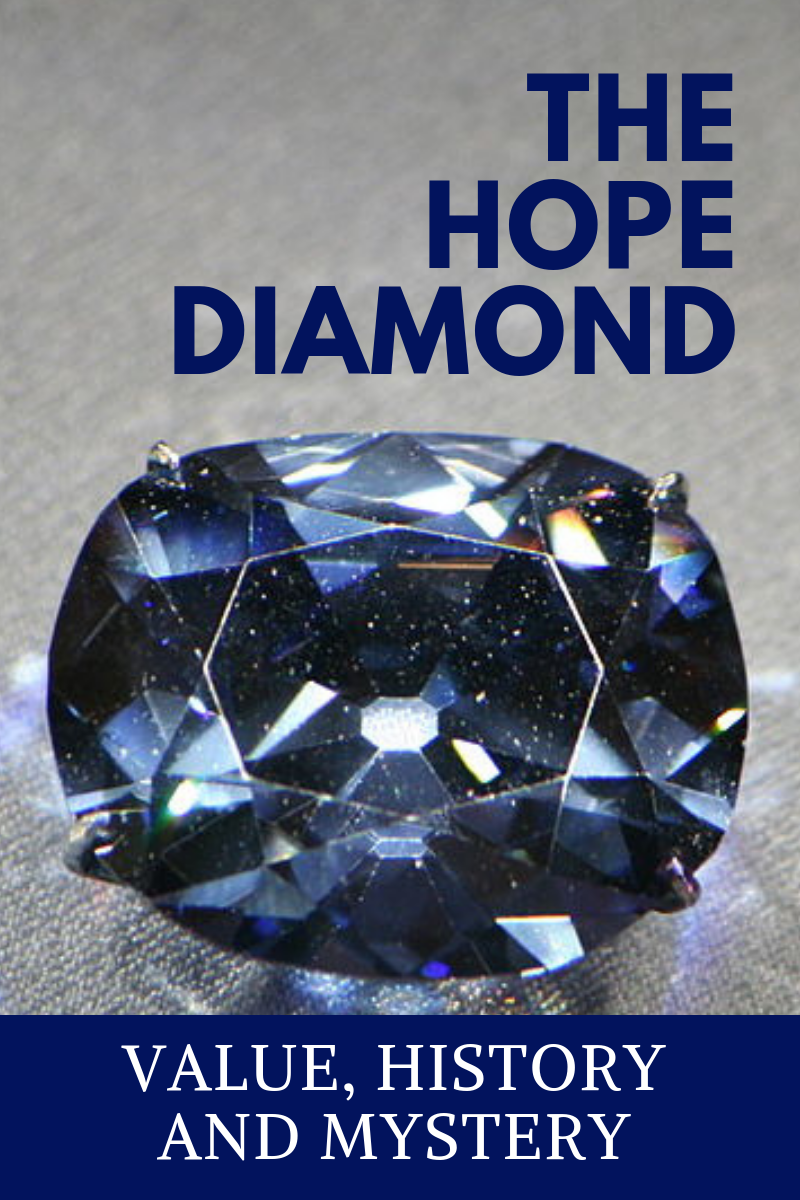
公開日15th Jan 2019
変更日時4th Jun 2025
ホープダイヤモンド - 価値、歴史、そして謎
 何世紀にもわたり、ホープダイヤモンドは世界で最も有名かつ最大級のカラーダイヤモンドの一つとして君臨してきました。裕福な所有者、泥棒、フランス王族といった大勢の所有者がいたことも、鮮やかな色と圧倒的な大きさ、あるいは呪われたという悪名高い評判のせいか、ホープダイヤモンドは今もなお最も話題となるダイヤモンドの一つです。所有者の記録は4世紀近くまで遡り、1958年にスミソニアン協会に寄贈されるまで、ホープダイヤモンドは数々の所有者の手に渡り、現在も国立自然史博物館に収蔵されています。
何世紀にもわたり、ホープダイヤモンドは世界で最も有名かつ最大級のカラーダイヤモンドの一つとして君臨してきました。裕福な所有者、泥棒、フランス王族といった大勢の所有者がいたことも、鮮やかな色と圧倒的な大きさ、あるいは呪われたという悪名高い評判のせいか、ホープダイヤモンドは今もなお最も話題となるダイヤモンドの一つです。所有者の記録は4世紀近くまで遡り、1958年にスミソニアン協会に寄贈されるまで、ホープダイヤモンドは数々の所有者の手に渡り、現在も国立自然史博物館に収蔵されています。
45.52カラットのホープダイヤモンドは、ファンシーダークグレイッシュブルーの輝きとVS1のクラリティ評価により、まばゆいばかりの美しさを放ちます。クッションカットのアンティークブリリアントカットダイヤモンドは、ガードルにファセットカットが施され、パビリオンにはさらにファセットが施され、ペアシェイプとクッションカットの16個のホワイトダイヤモンドがペンダントトップにセットされています。
ホープダイヤモンドの特別な点は何ですか?
2018年8月に行われた最近の調査によると、ホープダイヤモンドのようなブルーダイヤモンドは、地球上で最も希少なダイヤモンドの一つであることが判明しました。その後行われた約1,380万個のダイヤモンドを対象とした最近の調査では、ブルーダイヤモンドに分類されるのはわずか0.02%でした。
さらに、ネイチャー誌に掲載されたこの研究は、ブルーダイヤモンドが無色のダイヤモンドの4倍の深さ、つまり地表から400マイル(約640キロメートル)以上の深さで形成されることを示唆しています。ブルーダイヤモンドの起源は長い間、地質学者や宝石商にとって謎のままでしたが、この新たな研究は、幻のホープダイヤモンドのようなブルーダイヤモンドを生み出す複雑な地質学的層序についての洞察をもたらしました。
ホープダイヤモンドの歴史
インドのゴルコンダにあるコルール鉱山で産出されたと考えられているホープダイヤモンドは、17世紀にフランス人商人ジャン・バティスト・タヴェルニエによって購入された当時は、はるかに大きな石でした。タヴェルニエは後に、112 3/16カラットのダイヤモンドを美しい紫色で、やや粗削りな三角形にカットされていたと評しました。大きな石はすぐにタヴェルニエ・ブルーと名付けられ、ホープダイヤモンドよりも60カラット以上も大きく、結局のところ、ホープダイヤモンドはかつての石のほんの一部に過ぎませんでした。興味深いことに、専門家はホープダイヤモンドがタヴェルニエ・ブルーからカットされたのではないかと常に疑っていましたが、大きな石の子孫であることが証明されたのは2005年になってからでした。

1668年、タヴェルニエはこのダイヤモンドを、他の大粒のダイヤモンドや小粒のダイヤモンドと共にルイ14世に売却しました。王立芸術協会誌によると、タヴェルニエ・ブルーはヨーロッパで初めて記録されたブルーダイヤモンドとなり、その鮮やかな鋼鉄のような青色から「王冠のブルーダイヤモンド」または「フレンチブルー」として知られるようになりました。購入から5年後、ルイ14世は宮廷宝石商ピトー氏にこのダイヤモンドを1/8カラットにカットさせました。石の最高のファセットとまばゆい輝きを際立たせたいと考えたルイ14世は、このダイヤモンドを金にセットし、首にかけるリボンに通して儀式の際に身に着けました。
1749年、ルイ15世は宮廷宝石商アンドレ・ジャックマンに金羊毛騎士団のために、印象的な赤いスピネルを石にセットさせました。フランス革命前の数年間、フランス君主たちはこの美しく希少な宝石を身に付け続けました。歴史的証拠はありませんが、マリー・アントワネットでさえこの美しいフレンチブルーを何度も身に着けていたと多くの人が信じています。フランス革命中の1791年、ルイ16世とマリー・アントワネットがフランスから逃亡しようとした後、フランス王室の宝飾品は安全のために政府に引き渡されました。1792年の1週間に及ぶ略奪の間に、フレンチブルーを含むフランスの王冠宝石の大部分が盗まれました。長年、ルイ16世がフレンチブルーの最後の所有者であると信じられていました。
タヴェルニエと同じ美しいバイオレットの色合いを持つ、45.52カラットの小さめのブルーダイヤモンドが、19世紀初頭になってようやくイギリスで発見されました。ロンドンのダイヤモンド商、ダニエル・エリアソンの所有物でした。強力な証拠から、これは実際にはリカットされたフレンチブルーであったことが示唆されています。いくつかの文献によると、このダイヤモンドは最終的に国王ジョージ4世の手に渡りましたが、1830年の彼の死後、莫大な負債の返済に充てるため、私的なルートを通じて売却された可能性が高いです。
1839年、このダイヤモンドは、今日このダイヤモンドの名前の由来となった著名なヘンリー・フィリップ・ホープの宝石コレクション・カタログに掲載されました。しかし残念ながら、カタログには彼がどのようにしてこのダイヤモンドを入手したのか、またいくら支払ったのかを示す証拠は一切残っていません。同年後半に彼が亡くなった後、ダイヤモンドは甥のヘンリー・トーマス・ホープに、そして甥の孫であるフランシス・ホープ卿に受け継がれました。その後数年間、このダイヤモンドは幾人かの所有者の手に渡り、1909年にピエール・カルティエに売却されました。1910年、このホープ・ダイヤモンドはパリのカルティエで、ワシントンD.C.の社交界の名士エヴァリン・ウォルシュ・マクリーン夫人に披露されました。カルティエはダイヤモンドをセットし、大きな白いダイヤモンドを3段に並べたサークレットのヘッドピースとして取り付けた後、1911年にマクリーン夫人に売却しました。その後まもなく、ホープ・ダイヤモンドは今日まで残るネックレスのペンダントとなりました。

1947年にマクリーン夫人が亡くなると、ニューヨーク市のハリー・ウィンストン社が彼女のジュエリーコレクション全体を買収しました。その中には1949年にホープダイヤモンドも含まれていました。その後10年間、ホープダイヤモンドは世界中の多くの展覧会やチャリティイベントで展示され、その後スミソニアン協会に寄贈されました。現在も同協会の主要な見どころとなっています。1958年11月10日にスミソニアン協会に収蔵されて以来、ホープダイヤモンドは展覧会や清掃・修復作業のためにスミソニアン協会から持ち出されたのはわずか4回です。4世紀にも及ぶ豊かな歴史を持つホープダイヤモンドが、世界中の多くの人々に愛され続けているのも不思議ではありません。
希望のダイヤモンドの呪い
ホープダイヤモンドの最も興味深い点は、おそらく過去4世紀にわたり、所有者に降りかかってきたとされる呪いでしょう。伝説によると、ホープダイヤモンドは、この宝石を所有し身に着けた人に、自殺、殺人、破産、破局、悲劇といった大きな不幸をもたらすと言われています。しかし、これらの物語は、この美しい宝石の知名度を高め、ひいては価値を高めるために捏造されたものである可能性を示唆する強い証拠があります。とはいえ、この伝説にはある程度の真実が含まれていることを示唆する十分な証拠も存在します。
この伝説は、ジャン=バティスト・タヴェルニエが南インド、ゴルカンダのコルール鉱山でブルーダイヤモンドを発見したことに遡ります。このダイヤモンドは以前、ヒンドゥー教の女神像の頭部に、おそらく目として埋め込まれていたと考えられています。タヴェルニエ自身が像からダイヤモンドを盗んだという説もあれば、別の人物が盗んだダイヤモンドをフランス人に売ったという説もあります。いずれにせよ、どの伝説も、この窃盗行為が最初に石に呪いをかけたという点で一致しています。その後、タヴェルニエは犬に襲われて死亡したという説もありますが、証拠から、彼は宝石をフランス国王ルイ14世に売却した後、裕福な男として引退したと推測されます。
20世紀初頭、多くの新聞がホープダイヤモンドにまつわる不運を列挙した記事を掲載し、呪いの伝説はさらに広まりました。1911年のニューヨーク・タイムズ紙の記事では、ルイ16世とその妻マリー・アントワネットの斬首、ジャック・コレの自殺、さらには一時的にダイヤモンドを身に着けていたランバル公女の恐ろしい強姦と殺害など、ダイヤモンドの呪いを示唆する事例が列挙されていました。

後に、エヴァリンとネッド・マクリーンがパリのカルティエ店を訪れた際に、宝石商ピエール・カルティエがウィルキー・コリンズの小説『ムーンストーン』の要素をホープ・ダイヤモンドの物語に取り入れ、ささやかれる噂をさらに煽ったのではないかと考えられています。カルティエは、彼らにダイヤモンドを購入させるためにこの話を脚色したと考えられています。この話はエヴァリンを魅了し、後にダイヤモンドを購入させ、彼女はすぐにホープ・ダイヤモンドの最も象徴的な所有者の一人となりました。証拠は、この呪いが20世紀にホープ・ダイヤモンドの知名度、神秘性、魅力を高めるために捏造されたことを示唆していましたが、その後も不幸は続き、マクリーン夫人の義母が亡くなり、息子が9歳で死亡、夫が別の女性と離婚し、その後まもなく精神病院で死亡、娘が25歳で薬物の過剰摂取で死亡、そして一家は破産して財産を失いました。
1958年にハリー・ウィンストンからスミソニアン博物館にダイヤモンドが寄贈された後、それを届けた郵便配達員も、その後すぐに足を圧迫骨折し、自宅が火事になり、妻と犬もすぐに亡くなりました。
これらの不幸はホープダイヤモンドのせいだと信じる人が多い一方で、単なる偶然の一致であり、他の原因のせいだと主張する人もいます。スミソニアン博物館の学芸員ジェフリー・ポスト氏はPBSに対し、この呪いはダイヤモンドの歴史において興味深い部分ではあるものの、真実ではないと述べました。
「ホープダイヤモンドの物語において、呪いはダイヤモンドをこれほど有名にした魅力的な要素の一つです。しかし、科学者として、そしてキュレーターとして、私は呪いを信じていません」とポスト氏は述べた。
呪いを信じるかどうかに関わらず、ホープダイヤモンドの4世紀以上に遡る悪名高い歴史は、きっと興味深い読み物となるでしょう。ホープダイヤモンドのようなブルーダイヤモンドの美しさと希少性に魅了されている方は、ジェムロックオークションで今すぐご購入いただけます。
ブルーダイヤモンドを買う
Gemstone Encyclopedia検索
関連記事
誰もが自分の星座に対応した宝石を持っています。これらはスターストーンとも呼ばれています。これらの石についてもっと詳しく知り、あなたのスターストーンを見つけましょう。
10th May 2018
タヒチ真珠は、さまざまな形、サイズ、色がある、美しい濃い色の真珠です。この宝石について詳しく知り、当社が販売している美しい真珠をご覧ください。
9th May 2018
金塊はどのように形成されるのでしょうか?多くの金塊は、多くの宝石が形成されるのと同様に、溶融した金が流動性を持ち、母岩の亀裂や割れ目に浸透することで形成されます。
15th Oct 2020
最新記事
ヤシ象牙彫刻は、植物象牙とも呼ばれ、南米のヤシ科植物フィテレファス属のヤシの実から倫理的に採取された、象牙の天然代替品です。このガイドでヤシ象牙についてすべて学びましょう!
15th Jan 2026
レインボーラティスサンストーンは、様々な内包物によって3つのゴージャスな光学的効果を持つ長石の一種です。燃えるように鮮やかな色合いと格子模様が、コレクターにとって希少な宝石となっています。
12th Jan 2026
記事のカテゴリ
How To's is where you will find helpful articles from gem Rock Auctions on how to cut gemstones, select gemstones and buy gemstones.
9記事数

